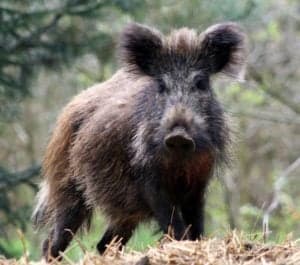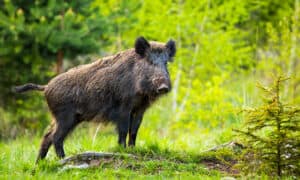Introduction
Wild pigs are a non-native and often invasive species within North America. While hybrid pigs in the United States cause significant ecological damage, “super pigs” in Canada are an even greater threat. Some consequences of super pig presence include the destruction of agriculture, soil erosion, the decline in the population of other species, and the spread of disease. While super pigs primarily reside in Canada, their populations and range are expanding rapidly, causing some to believe that they might migrate to the northern United States. Discover what super pigs are and find out why they threaten the environment and other animal populations.
Background On Wild Pigs’ History

A historical drawing of a wild boar.
©Editor Ambrose Stevens Illustrator William Harvey / Public Domain – License
New World explorers such as Christopher Columbus and Hernando de Soto introduced North America to wild pigs during the early sixteenth century. The explorers intended to create a domestic population of pigs within the continent. However, many of these pigs escaped, and the wild pig population was established.
In the early 1900s, wild Eurasian boars were brought to America and bred with feral pigs already present in the United States. As a result, a hybrid species was born. Now, pigs in the United States mainly belong to one of three categories: wild boars, feral pigs, and hybrid pigs. However, the three categories of pigs are considered the same species overall and are invasive species in the United States. In fact, more than six million wild pigs reside throughout the country.
Diet And Behavior
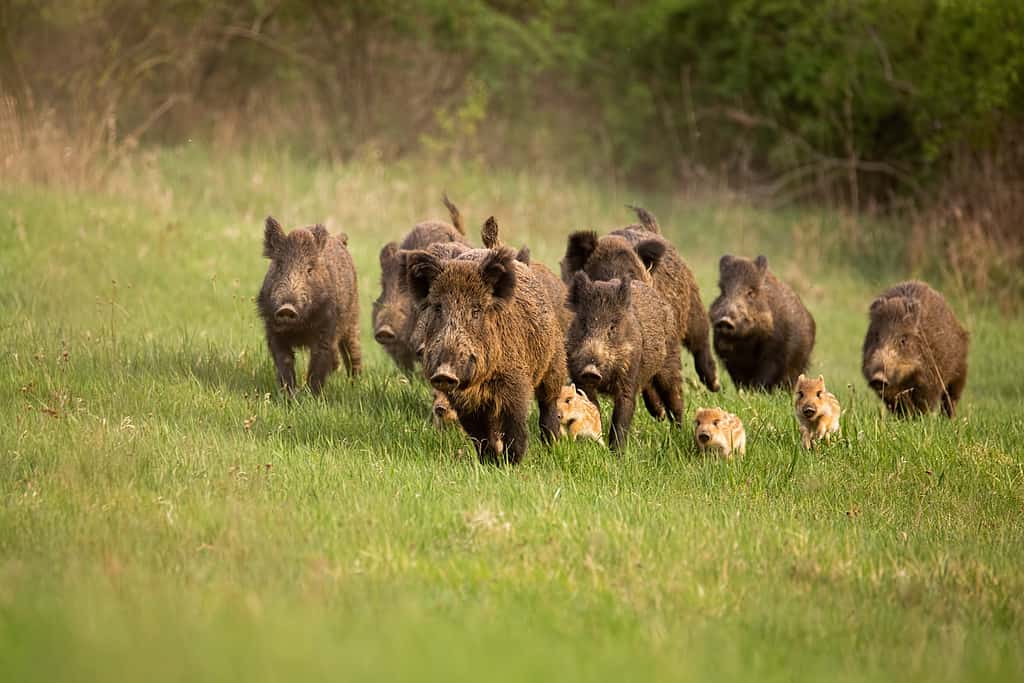
Many wild pigs form groups called “sounders,” which typically travel together.
©iStock.com/JMrocek
Wild pigs can live between four and five years on average and produce between one and three litters annually. Female wild pigs typically reach sexual maturity after one year. Litters of wild pigs usually include between four and six offspring. Many wild pigs form groups called “sounders,” which typically travel together. However, the wild pigs within these groups are usually female or juvenile pigs. Male wild pigs, or boars, are solitary animals that travel alone.
Wild pigs can be encountered in shaded areas or near bodies of water. These animals do not have sweat glands to keep them cool in the day’s heat. Thus, they often attempt to find shade or bodies of water to keep them cool. Lack of sweat glands also causes wild pigs to be less active during the day when temperatures and sunlight are at their highest intensities. Unfortunately, the presence of wild pigs near bodies of water can create bacteria in the water that negatively impacts ecosystems and water quality.
Wild pigs are omnivores, meaning they will eat nearly anything that comes across their path. While they primarily consume vegetation, they have also been known to eat livestock, such as lambs and kids, bird eggs, reptiles, amphibians, and more. Some predators of young wild pigs include foxes, bobcats, and coyotes. The greatest threats to wild pigs are mountain lions and humans. Overall, though, very few predators prefer to attack and consume wild pigs, resulting in a lack of stable wild pig population numbers and rapid population growth of the species.
Why Are They Dangerous?
Wild pigs are extremely destructive in agricultural settings. Crops are an easily accessible food source for wild pigs. They prefer crops like sugar cane, corn, wheat, oats, lettuce, and much more. When wild pigs trample through fields, create wallows, engage in rooting behavior, and tear up crops for consumption, damage can encourage invasive plant growth or create hazardous conditions for farm equipment and workers.
Finally, several serious diseases can be passed from wild pigs to other animals, livestock, and humans. Some of these illnesses include swine brucellosis, Lyme disease, pseudorabies, Tularemia, and more. Swine brucellosis in humans causes symptoms much like those experienced when a person contracts the flu. Livestock contracting pseudorabies may experience intense itching or fever, and the disease can be fatal. Tularemia in humans can lead to more severe illnesses like pneumonia or meningitis.
How To Determine If Wild Pigs Live In Your Area
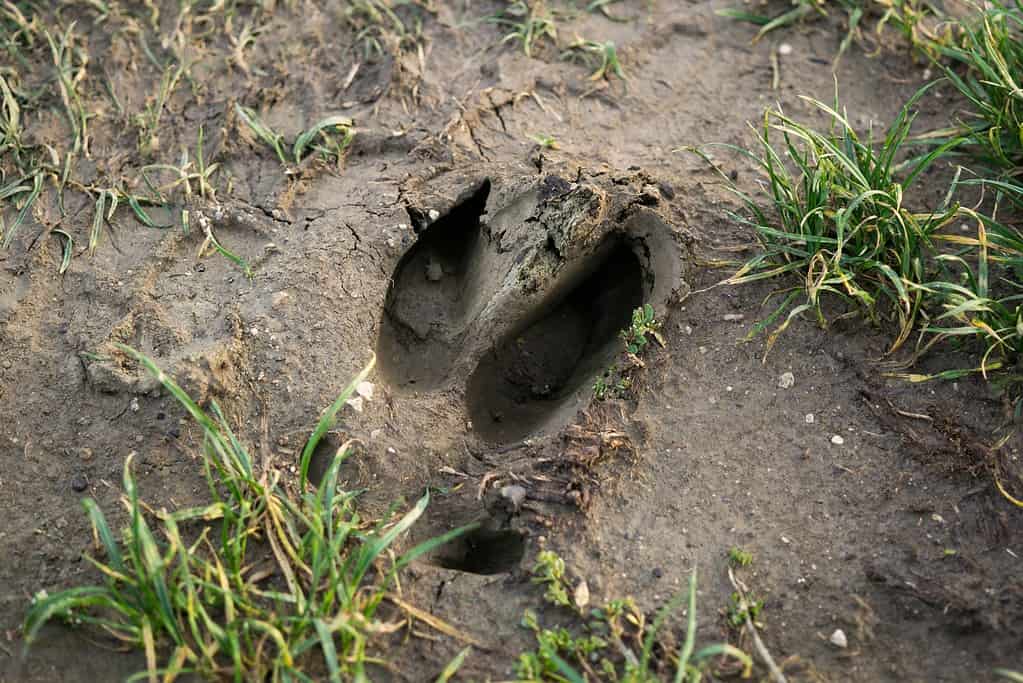
Tracks in mud or on soft ground also indicate wild pig presence. Wild pig tracks will show rounded toes.
©Vechterova Valeria/Shutterstock.com
Wild pigs are unlikely to stay in one place for an extended period. The species tends to move around frequently, allowing them to expand their range as they easily adapt to numerous environments, climates, and diets. Certain signs of wild pig presence exist, allowing people to recognize whether wild pig populations live near them and whether they are a threat.
For instance, one example of wild pig presence includes damage due to rooting behavior. Rooting behavior occurs when pigs use their nose to push into something repeatedly. In most cases, rooting behavior happens when wild pigs are in search of food. Wallows are also a common sighting when wild pigs are present. Wallows are depressions in mud or muddy water made by wild pigs attempting to escape the heat. Wild pigs will create wallows to cover themselves in mud, which helps them cool off and keep away insects.
Tracks in mud or on soft ground also indicate wild pig presence. However, wild pig tracks are often confused with other animal tracks, like white-tailed deer. Wild pig tracks will show rounded toes, as opposed to the white-tailed deer’s pointed toes visible in their tracks. Since wild pig tracks are difficult to distinguish, searching for other signs of wild pig presence will be useful in determining if they reside nearby. Other signs of wild pig presence include droppings or hair and mud left on wire or fences.
What Are “Super Pigs”?
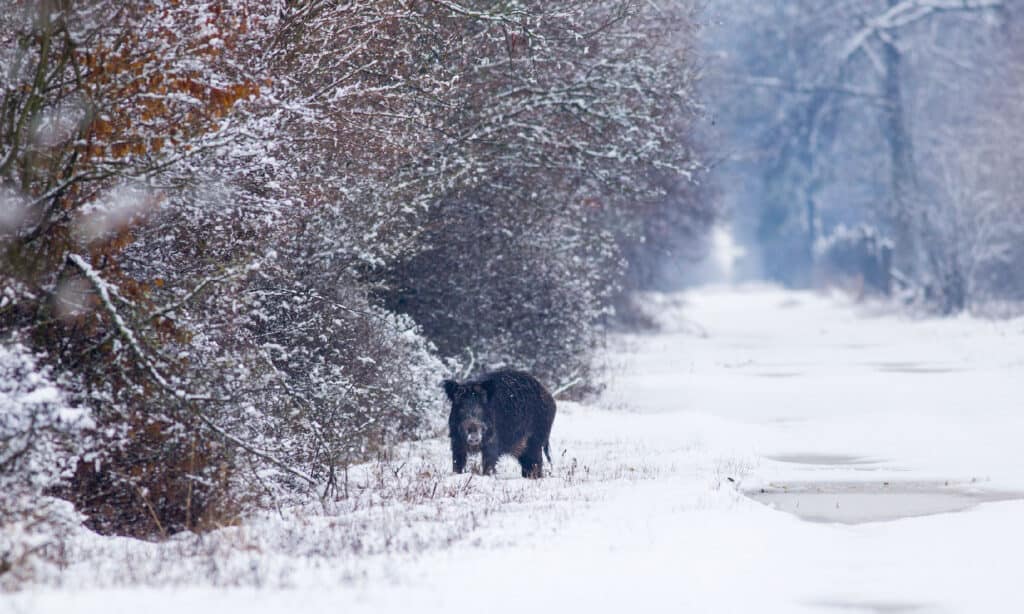
Super pigs are able to withstand the Canadian cold. They burrow into the snow, creating insulated tunnels that keep them warm.
©iStock.com/Jevtic
Super pigs are hybrid species resulting from mating or breeding between wild and domestic pigs. In Canada, wild pigs from Europe were introduced in the 1980s. Super pigs resulted when farmers began to breed the already existent population of feral Canadian pigs with those from Europe of recent introduction. Farmers decided to breed the two groups in this way because they believed that super pigs would provide more meat and be easier targets to shoot.
Canadian farmers did not originally see the super pigs as threats. In fact, it was believed that if a super pig were to escape, it would simply freeze to death in Canada. Therefore, no one could have foreseen how these super pigs would adapt to their environment. Now, super pigs are able to withstand the Canadian cold. They burrow into the snow, creating insulated tunnels that keep them warm.
Wild pigs in Canada cover approximately 300,300 square miles as of 2019 and continue to enlarge their range by nearly 34,000 square miles annually. Most super pigs weigh between 120 and 250 pounds. However, some grow much larger, recording weights up to 660 pounds.
The threat of super pigs is excellent in this country because they are innately destructive creatures. For instance, super pigs eat Canadian crops and intensely consume small mammals and reptiles. They also cause extreme soil erosion and carry dangerous diseases. Clearly, the presence and expanding range of super pigs is an environmental threat that could become an ecological disaster.
Are Super Pigs Coming To The United States?
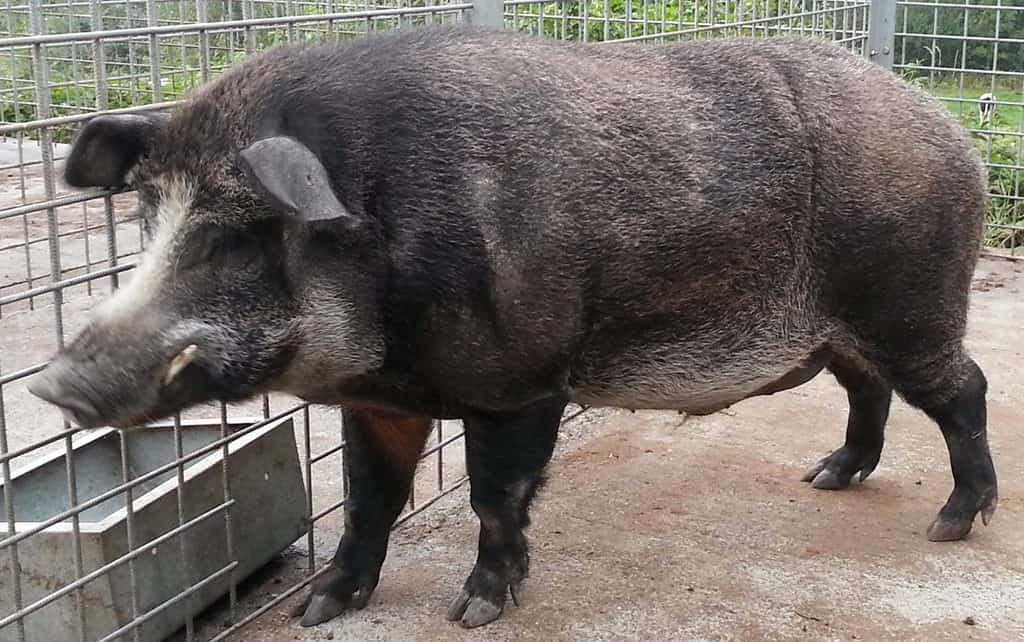
A male wild boar-domestic pig hybrid is also referred to as a super pig.
©Miguel Tremblay / CC0 1.0 – License
Some experts claim that super pigs have been spotted within 10 miles of the United States-Canada border. Furthermore, others speculate that these animals have already made their way into states such as North Dakota. With no physical border between Canada and the United States, it’s easy to see why these pigs would be able to cross into the United States in the coming years. Due to their diet and behavior, super pigs in the United States could disrupt the food chain, destroy agriculture and other property, and cause disease and ecological disaster.
Another fact about super pigs is that they are highly intelligent. Super pigs can recognize when they are being hunted or threatened, allowing them to change their course of action to survive. For instance, if a super pig realized it was being hunted, it might become nocturnal or hide in brush, forests, or dense wetlands to evade capture or death. If super pigs were to move into the United States, disposing of them or attempting to remove them from United States land would prove challenging, if not impossible.
The photo featured at the top of this post is © Marko25/Shutterstock.com
Thank you for reading! Have some feedback for us? Contact the AZ Animals editorial team.





